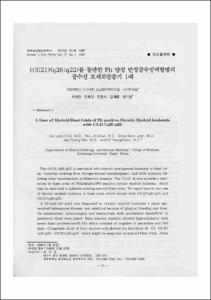KUMEL Repository
1. Journal Papers (연구논문)
1. School of Medicine (의과대학)
Dept. of Laboratory Medicine (진단검사의학)
t(3;21)(q26;q22)를 동반한 Ph 양성 만성골수성백혈병의 골수성 모세포발증기 1예
- Keimyung Author(s)
- Chun, Hyo Jin; Jeon, Dong Seok; Kim, Jae Ryong; Kwon, Ki Young
- Journal Title
- 대한임상병리학회지
- Issued Date
- 1997
- Volume
- 17
- Issue
- 1
- Keyword
- Chronic Myeloid Leukemia; Blast Crisis; t(3:21)
- Abstract
- The t(3:21) (q26:q22) is associated with chronic myelogenous leukemia in blast crisis, leukemia evolving from therapy-related myelodysplasia, and with leukemia following other hematopoietic proliferative diseases. The t(3:21) is rare secondary aberration in blast crisis of Philadelphia(Ph)-positive chronic myeloid leukemia, which may be restricted to patients entering myeloid blast crisis. We report here in one case of chronic myeloid leukemia in blast crisis which reveals both t(9:22) (q34:q11), and t(3:21) (q26:q22). A 62-year-old male was diagnosed as chronic myeloid leukemia 5 years ago, received hydroxyurea therapy, and admitted because of gingival bleeding and fever. On examination, splenomegaly and leukocytosis with proliferated blasts(91%) in peripheral blood were noted. Bone marrow aspirate showed hypercellularity with severe blast proliferation(92.5%) which revealed all negative in peroxidase and PASstain. Cytogenetic study of bone marrow cells showed the karyotype 46, XY, t(3:21)(q26:q22), t(9:22) (q34:q11), which might be suspected as myeloid blast crisis. Above finding was confirmed by the result of immunophenotyping(CD13 43.6%. CD34 68.2%, HLA-DR 91.6%). He received intensive chemotherapy, but still sustained proliferation of blasts was noted. The follow up cytogenetic study was as follows: 46,XY, t(3:21)(q26:22), t(9:22)(q34:q11)/46, XY, t(3:21)(q26:q22), del(8)(q22), t(9:22)(q34: q11)/46,XY (16/3/1). He died soon from severe pancytopenia and sepsis.
- Alternative Title
- A Case of Myeloid Blast Crisis of Ph-positive Chronic Myeloid Leukemia with t(3;21)(q26;q22)
- Publisher
- School of Medicine
- Citation
- 최귀전 et al. (1997). t(3;21)(q26;q22)를 동반한 Ph 양성 만성골수성백혈병의 골수성 모세포발증기 1예. 대한임상병리학회지, 17(1), 21–27.
- Type
- Article
- ISSN
- 1015-6445
- 파일 목록
-
-
Download
 oak-bbb-3400.pdf
기타 데이터 / 1.95 MB / Adobe PDF
oak-bbb-3400.pdf
기타 데이터 / 1.95 MB / Adobe PDF
-
Items in Repository are protected by copyright, with all rights reserved, unless otherwise indicated.